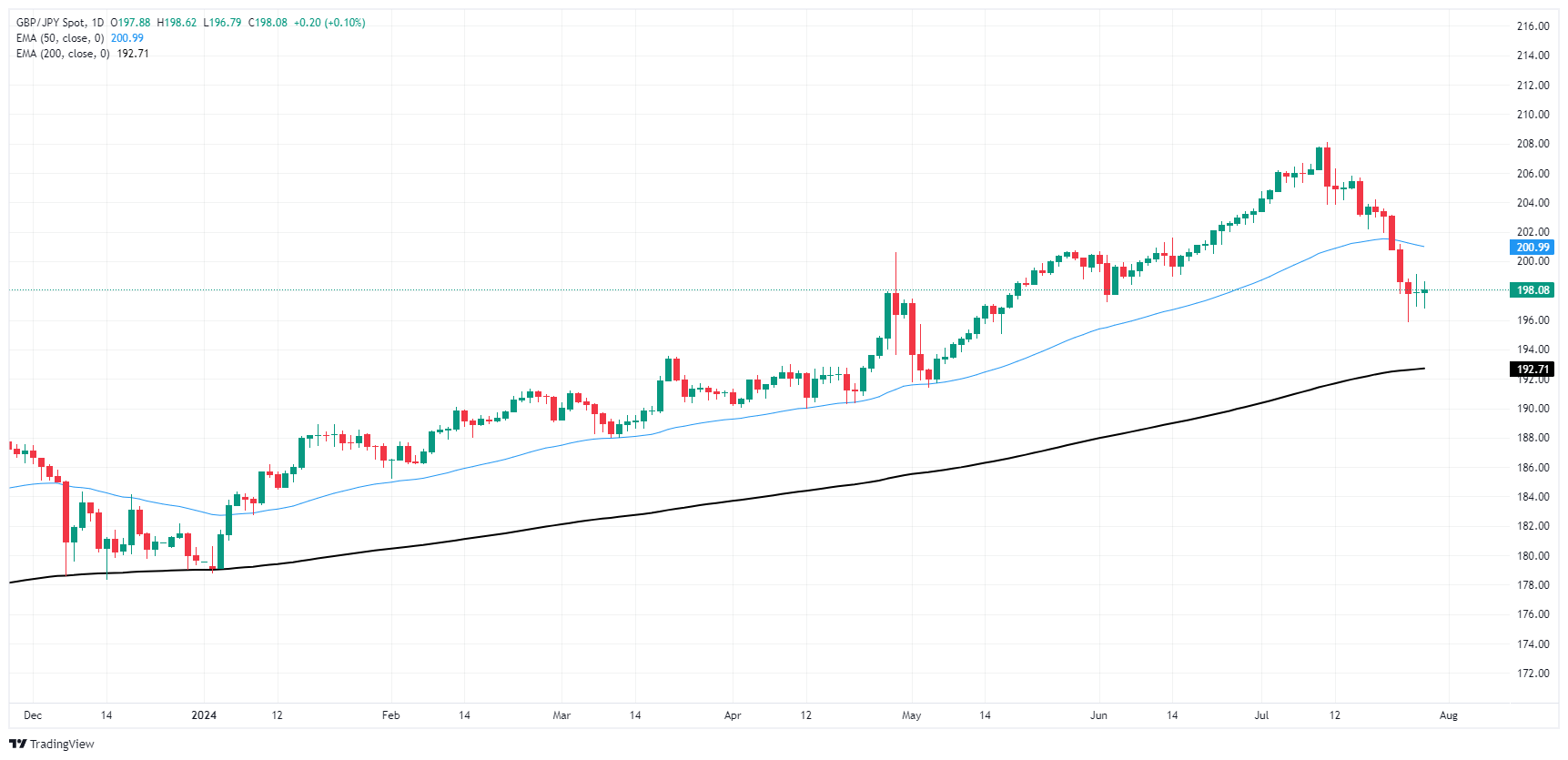- Analytics
- News and Tools
- Market News
- GBP/JPY draws spinning tops as BoJ and BoE loom
GBP/JPY draws spinning tops as BoJ and BoE loom
- GBP/JPY gets comfortable near 198.00 as Guppy traders wait for a reason to move.
- BoJ and BoE rate calls due this week, UK rate cut expected.
- JPY traders on the lookout for signs of a shift from BoJ, confirmation of “Yenterventions”.
GBP/JPY is in the process of drawing a second straight spinning top daily candle on Monday as Guppy traders await signals to move in either direction with rate decisions from both the Bank of Japan (BoJ) and the Bank of England (BoE) on the books for this week.
The BoE is broadly expected to deliver a quarter-point rate trim later this week on Thursday, but odds are still up in the air with the Monetary Policy Committee (MPC) forecast to vote 5–to-4 in favor of a 25 bps rate cut. At the BoE’s previous rate meeting, the MPC voted 7-to-2 in favor of keeping rate cuts on hold.
The BoJ is also due for a rate call this week and slated for the early Wednesday market session, but markets have broadly lower expectations for the Japanese central bank. The BoJ remains bound and determined to keep Japanese interest rates at or near zero until they figure out a way to spark healthy, long-run inflation near 2%, and steadily declining Japanese inflation figures are keeping rate hikes at bay even as headline inflation figures continue to run above the 2% target.
Market participants will also be looking for official confirmation from BoJ officials that the Japanese central bank stepped directly into foreign currency markets to defend the beleaguered Yen, which was abruptly bolstered in several sessions in recent weeks.
GBP/JPY technical outlook
The Guppy is set to price in a second straight spinning top daily candle as investors await changes in the rate differential between the Pound Sterling and the Yen. GBP/JPY bottomed out near the 196.00 handle after a series of suspected “Yenterventions” dragged the pair down nearly 6% from 16-year highs at 208.11.
The Guppy is still trading in bull territory north of the 200-day Exponential Moving Average (EMA) at 192.71, but buyers will have to work hard to push bids back above the 50-day EMA at 201.00.
GBP/JPY daily chart
Pound Sterling FAQs
The Pound Sterling (GBP) is the oldest currency in the world (886 AD) and the official currency of the United Kingdom. It is the fourth most traded unit for foreign exchange (FX) in the world, accounting for 12% of all transactions, averaging $630 billion a day, according to 2022 data. Its key trading pairs are GBP/USD, aka ‘Cable’, which accounts for 11% of FX, GBP/JPY, or the ‘Dragon’ as it is known by traders (3%), and EUR/GBP (2%). The Pound Sterling is issued by the Bank of England (BoE).
The single most important factor influencing the value of the Pound Sterling is monetary policy decided by the Bank of England. The BoE bases its decisions on whether it has achieved its primary goal of “price stability” – a steady inflation rate of around 2%. Its primary tool for achieving this is the adjustment of interest rates. When inflation is too high, the BoE will try to rein it in by raising interest rates, making it more expensive for people and businesses to access credit. This is generally positive for GBP, as higher interest rates make the UK a more attractive place for global investors to park their money. When inflation falls too low it is a sign economic growth is slowing. In this scenario, the BoE will consider lowering interest rates to cheapen credit so businesses will borrow more to invest in growth-generating projects.
Data releases gauge the health of the economy and can impact the value of the Pound Sterling. Indicators such as GDP, Manufacturing and Services PMIs, and employment can all influence the direction of the GBP. A strong economy is good for Sterling. Not only does it attract more foreign investment but it may encourage the BoE to put up interest rates, which will directly strengthen GBP. Otherwise, if economic data is weak, the Pound Sterling is likely to fall.
Another significant data release for the Pound Sterling is the Trade Balance. This indicator measures the difference between what a country earns from its exports and what it spends on imports over a given period. If a country produces highly sought-after exports, its currency will benefit purely from the extra demand created from foreign buyers seeking to purchase these goods. Therefore, a positive net Trade Balance strengthens a currency and vice versa for a negative balance.
© 2000-2025. All rights reserved.
This site is managed by Teletrade D.J. LLC 2351 LLC 2022 (Euro House, Richmond Hill Road, Kingstown, VC0100, St. Vincent and the Grenadines).
The information on this website is for informational purposes only and does not constitute any investment advice.
The company does not serve or provide services to customers who are residents of the US, Canada, Iran, The Democratic People's Republic of Korea, Yemen and FATF blacklisted countries.
Making transactions on financial markets with marginal financial instruments opens up wide possibilities and allows investors who are willing to take risks to earn high profits, carrying a potentially high risk of losses at the same time. Therefore you should responsibly approach the issue of choosing the appropriate investment strategy, taking the available resources into account, before starting trading.
Use of the information: full or partial use of materials from this website must always be referenced to TeleTrade as the source of information. Use of the materials on the Internet must be accompanied by a hyperlink to teletrade.org. Automatic import of materials and information from this website is prohibited.
Please contact our PR department if you have any questions or need assistance at pr@teletrade.global.















